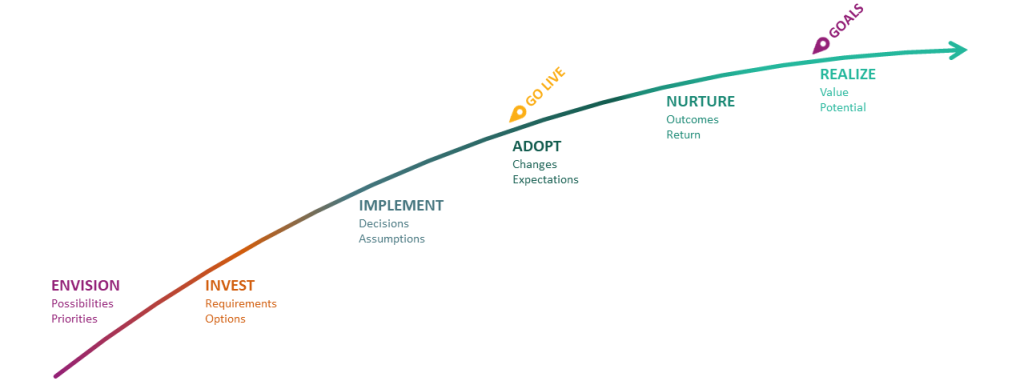By Chad Kainz
Have you ever wondered why only 8 out of 10 enterprise transformation initiatives are never declared a success? Or when transformation initiatives seem on track, how do they manage to succeed while still missing expected outcomes and goals?
For years, executives, transformation advisors, and change experts have applied John Kotter’s classic Eight-Stage Process for Leading Change to enterprise-scale transformation:
- Establish a sense of urgency
- Create the guiding coalition
- Develop a vision and strategy
- Communicate the change vision
- Empower employees for broad-based action
- Generate short-term wins
- Consolidate gains and produce more change
- Anchor new approaches in the culture
His original concept largely viewed change as a flat project-like path. Our transformation team expanded on his viewpoint. Below we’ve illustrated a transformation path that reinterprets Kotter’s stages into six distinct periods:
- Envision
- Invest
- Implement
- Adopt
- Nurture
- Realize
Transformation rarely occurs without some type of indicative milestone, so the enterprise system Go-Live serves as the key inflection point and Goals indicate where value-on-investment (VOI) is realized:

While generally accepted as a leading practice for driving lasting change, we’ve found that Kotter’s flat model runs afoul when used for enterprise transformation. In 2019, Seth Goldstrom shed light as to why this may be the case. First, he notes that when transformations fail often the “top team isn’t aligned around the change story or the change story isn’t really compelling from a hearts-and-minds perspective.” His observation points toward misalignment in the Envision and Invest periods that don’t necessarily lead to the same outcomes. He adds that performance aspirations set by the organization are not always based on expected or attained full potential. In other words, goals are not aspirational in nature, which dilutes value and reduces the effectiveness of the Nurture and Realize periods of transformation.
Separately, Mattias Schramm sees transformation as a journey and not an implementation. He goes on to point out that today, “leaders focus on creating sophisticated plans with objectives that will be achieved years in the future.” The key issue lurking behind this notion is once again alignment, compounded by what may come but not necessarily seen or understood by all along the path. Grand transformation efforts don’t necessarily consider the time it takes to adopt change and the resilience needed to make course corrections to ultimately realize value.
At CrossVue, we’ve found that the flat model used by so many to drive transformation efforts is flawed. Instead, we like to think of transformation as following an arc where we’re always looking over the horizon and making adjustments to be on target with goals and expectations:
Horizon Transformation Model

With CrossVue’s Horizon Transformation Model, we encourage leaders to elevate and look to the farthest horizon to Envision possibilities that push the organization and expand its potential as early as possible. By having a view of the horizon, actions to Invest take those priorities (Goals) and plot a path toward what people can realistically Adopt. Implement is close to the people, processes and technologies needed to scaffold and drive holistic transformation. While the Nurture and Realize periods cannot be easily seen from a close-to-the-path Implement vantage point, adjustments can be made to keep work focused on the expected path because what we are trying to achieve is clear. As the initiative crests at its inflection point (in this case, go-live), the path to Realize value should be attainable, predictably aligned with what was defined as part of Envision and shaped during Invest.
The Horizon Transformation Model assumes we know what we want to attain in the future, but the appropriate path is not necessarily ideal, fixed, or clear. In this model, we work together to continually adjust our path based on what we’re assessing as we look to the horizon from different vantage points. The result is when we transition the Adopt period, our expectations are aligned with the goals we need to attain.
By design, this model expects leaders and those who shepherd transformation efforts to act at times as pragmatic futurists. Because true enterprise-wide transformation extends far beyond what we can realistically predict, leaders need to be part futurist and seek patterns that may indicate what may happen. They also need to be pragmatic and approach transformation from different elevations to observe and understand what is coming. With better knowledge of what is on the horizon, they can make informed decisions and adjustments along the path, staying on target to achieve long-term goals and realize value. And, ideally, the result should develop organizational resilience.
While this model may seem complex, it is something we often experience. When we’re peering out of an airplane window during takeoff or landing, seeing one of four states from atop the Willis Tower in Chicago, or listening to the outdoors out of a second-story window, we are experiencing the horizon in a different way and developing ideas rooted in that experience. Because we can gather more information from an elevated perspective, we are able to incorporate a broader vision of what is around us, be better equipped to understand and articulate what’s possible to those who are on the ground, and guide people to where we need to go.
Transformation at CrossVue focuses on driving actionable outcomes that help organizations attain meaningful value from their Workday investment. Our approach, CrossVue Complete, is holistic by design and centered on action to keep projects focused on the future and drive transformation success well after go-live. If you’d like to learn more about CrossVue or our approach to transformation, feel free to contact CrossVue’s team of experts.
CrossVue is a contemporary consulting firm providing the blueprint for modernizing client operations and processes through Workday. As a leading Workday advisory, deployment, and post-production support firm, we drive critical results for our clients and help them reach their transformation goals through the Workday platform. For more information, visit www.crossvue.com
Sources:
Kotter, John P. Leading Change. Harvard Business School Press, 1996.
Harvard Business Review. (2021, November 29). The secret behind successful corporate transformations. Retrieved May 2023, from https://hbr.org/2021/09/the-secret-behind-successful-corporate-transformations
McKinsey & Company. (2019, February 15). Why Transformations Fail: A Conversation with Seth Goldstrom. Retrieved May 2023, from https://www.mckinsey.com/capabilities/strategy-and-corporate-finance/our-insights/why-transformations-fail-a-conversation-with-seth-goldstrom
Forbes Human Resources Council. (2021, March 2). Why Transformations Fail and What You Can Do About It. Forbes. Retrieved May 2023, from www.forbes.com/sites/forbeshumanresourcescouncil/2021/03/02/why-transformations-fail-and-what-you-can-do-about-it


